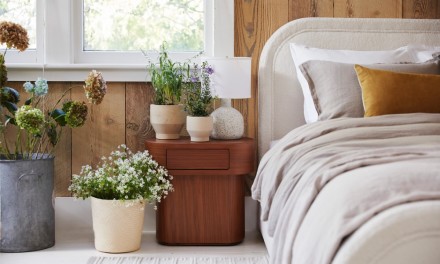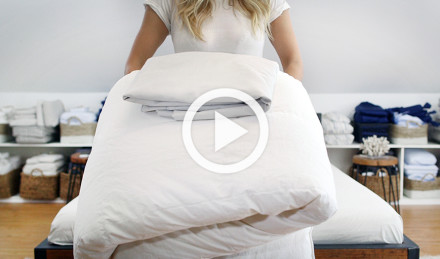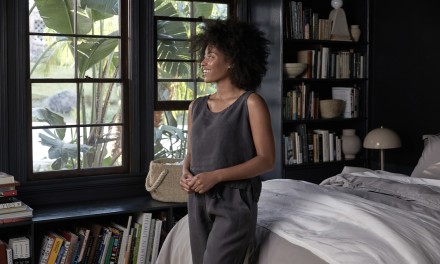After a successful bed frame launch, we are continuing to expand our furniture offerings with thoughtful finishing touches for the bedroom – and beyond. Introducing our Bluff Nightstands and Benches inspired by the beauty of our California home; from the curves of Laurel Canyon to the dunes of the Mojave.
Rounded edges are a common thread through our designs and continue in the Bluff Collection which features organic shapes, clean lines and modern twists on home furnishing staples. Like our entire assortment, this collection was designed by our in-house team. So we asked our Chief Creative Officer Amy Hoban and our Hardlines Design Manager Daniel Powell for all the details on the design and styling of our newest additions.
Can you share the process for designing the Bluff Collection? Did you design them alongside the bed frames?
Amy: When designing the Bluff Collection, we wanted to use shapes that worked well with our bed frames but were not exactly the same. I love the idea of bringing in different looks – some rounded corners, some traditional straight edges – so they could be easily incorporated into customers’ personal interior style.
Daniel: It made so much sense to me that we would someday design furniture for the bedroom to complement our textiles. While we started with bed frames, nightstands and benches were a natural next step for us in designing the complete bedroom.
Can you share the process for designing the Bluff Collection? Did you design them alongside the bed frames?
Amy: When designing the Bluff Collection, we wanted to use shapes that worked well with our bed frames but were not exactly the same. I love the idea of bringing in different looks – some rounded corners, some traditional straight edges – so they could be easily incorporated into customers’ personal interior style.
Daniel: It made so much sense to me that we would someday design furniture for the bedroom to complement our textiles. While we started with bed frames, nightstands and benches were a natural next step for us in designing the complete bedroom.
Soft, rounded edges are a common theme among our furniture pieces. What about this look keeps you coming back?
Amy: I love the look that soft edges on furniture convey. It’s a relaxing view for the eyes and, at least for me, feels synonymous with comfort.
Daniel: Comfort is at the heart of Parachute. We wanted the same cozy feel of our textiles to translate into the design language of our furniture, and soft edges and rounded corners evoke a sense of warmth and comfort.
Soft, rounded edges are a common theme among our furniture pieces. What about this look keeps you coming back?
Amy: I love the look that soft edges on furniture convey. It’s a relaxing view for the eyes and, at least for me, feels synonymous with comfort.
Daniel: Comfort is at the heart of Parachute. We wanted the same cozy feel of our textiles to translate into the design language of our furniture, and soft edges and rounded corners evoke a sense of warmth and comfort.
We are offering the pieces in white oak and walnut. What drew you to these wood selections?
Amy: White oak is having a moment in the furniture industry. The fixtures in our brick-and-mortar stores are white oak and we’ve had so many customers asking to buy them, so we thought it was an obvious place to start. We felt it would be received well, but not everyone wants light colored wood so we added a classic darker option: walnut.
Daniel: No two homes – or people, for that matter – are the same, so it was important to us to offer each silhouette in both dark and light wood. White oak and walnut are two classic North American hardwoods, and they have become visually synonymous with the Parachute brand.
We are offering the pieces in white oak and walnut. What drew you to these wood selections?
Amy: White oak is having a moment in the furniture industry. The fixtures in our brick-and-mortar stores are white oak and we’ve had so many customers asking to buy them, so we thought it was an obvious place to start. We felt it would be received well, but not everyone wants light colored wood so we added a classic darker option: walnut.
Daniel: No two homes – or people, for that matter – are the same, so it was important to us to offer each silhouette in both dark and light wood. White oak and walnut are two classic North American hardwoods, and they have become visually synonymous with the Parachute brand.
How do you envision the benches and nightstands styled in the bedroom? Do you prefer mixing your nightstands or having the same style on both sides of the bed?
Amy: We originally designed the benches for the end of the bed, but noticed they’re truly a multi-functional piece. They look great in an entryway or as seating at a dining table too. As for the nightstands, my favorite thing to do is place a different style on each side of the bed. I love asymmetry, but matching nightstands are a wonderful look as well.
Daniel: It’s easy to assume that the most important piece of furniture in the bedroom is the bed frame, but that’s not always the case. What really transforms a space are the smaller, layered pieces – like a bench placed at the end of the bed, near the door as a place to put your shoes on, or even styled with a few decorative pillows at the base of a window. I prefer not to mix and match different nightstand styles, but I do love the look of pairing a similar silhouette but having one with a drawer and one without. You can style them with books, a ceramic vase, or a lamp to complete the look.
How do you envision the benches and nightstands styled in the bedroom? Do you prefer mixing your nightstands or having the same style on both sides of the bed?
Amy: We originally designed the benches for the end of the bed, but noticed they’re truly a multi-functional piece. They look great in an entryway or as seating at a dining table too. As for the nightstands, my favorite thing to do is place a different style on each side of the bed. I love asymmetry, but matching nightstands are a wonderful look as well.
Daniel: It’s easy to assume that the most important piece of furniture in the bedroom is the bed frame, but that’s not always the case. What really transforms a space are the smaller, layered pieces – like a bench placed at the end of the bed, near the door as a place to put your shoes on, or even styled with a few decorative pillows at the base of a window. I prefer not to mix and match different nightstand styles, but I do love the look of pairing a similar silhouette but having one with a drawer and one without. You can style them with books, a ceramic vase, or a lamp to complete the look.
The benches are both beautiful, can you tell us more about papercord and what makes that special?
Amy: Danish papercord is the material used to weave typical seatbacks found in Danish, Scandinavian, and Mid-Century Modern furniture. I personally love the material. It’s durable and the texture of papercord alongside wood adds a certain depth and warmth to the design.
Daniel: Papercord is a versatile material made of three paper strands tightly twisted together that result in a strong, pliable material. The papercord we are familiar with today is most associated with chairs from the Danish Modern period and many of the great Mid-Century designers, like Hans Wegner, used papercord to create their most significant designs. These chairs are elegant and timeless, even decades later.
The benches are both beautiful, can you tell us more about papercord and what makes that special?
Amy: Danish papercord is the material used to weave typical seatbacks found in Danish, Scandinavian, and Mid-Century Modern furniture. I personally love the material. It’s durable and the texture of papercord alongside wood adds a certain depth and warmth to the design.
Daniel: Papercord is a versatile material made of three paper strands tightly twisted together that result in a strong, pliable material. The papercord we are familiar with today is most associated with chairs from the Danish Modern period and many of the great Mid-Century designers, like Hans Wegner, used papercord to create their most significant designs. These chairs are elegant and timeless, even decades later.
Do you see these pieces working beyond the bedroom? If so, how would you style in your living room or entry?
Amy: The bedside tables could easily become a fixture in the living room next to a sofa or chair. I can even see the Bluff Oval Nightstand being used as extra seating in the living room, or a stool in the bathroom next to the tub.
Daniel: During the naming process for these pieces we hesitated to use terms like “nightstand” or “bedside table” because we felt they could be used throughout the home, and we didn’t want anyone to feel limited in their design choices. All of the nightstands look great in a living room next to the sofa, and can be styled with a stack of books or a table lamp in the same way you’d style them in a bedroom.
Do you see these pieces working beyond the bedroom? If so, how would you style in your living room or entry?
Amy: The bedside tables could easily become a fixture in the living room next to a sofa or chair. I can even see the Bluff Oval Nightstand being used as extra seating in the living room, or a stool in the bathroom next to the tub.
Daniel: During the naming process for these pieces we hesitated to use terms like “nightstand” or “bedside table” because we felt they could be used throughout the home, and we didn’t want anyone to feel limited in their design choices. All of the nightstands look great in a living room next to the sofa, and can be styled with a stack of books or a table lamp in the same way you’d style them in a bedroom.
Furniture typically uses a lot of unsustainable packaging, like styrofoam. How have you approached the packaging design for the Bluff Collection in order to align with Parachute’s sustainability commitments?
Daniel: Sustainability is a focus in everything we design, and we’re always striving to improve – product packaging is no exception. Packaging for the Bluff Collection is entirely made up of heavyweight recyclable cardboard, and we were able to achieve the same level of protection for the pieces without using traditional, less sustainable packaging materials. You can read more about our Sustainability Commitments here.
Furniture typically uses a lot of unsustainable packaging, like styrofoam. How have you approached the packaging design for the Bluff Collection in order to align with Parachute’s sustainability commitments?
Daniel: Sustainability is a focus in everything we design, and we’re always striving to improve – product packaging is no exception. Packaging for the Bluff Collection is entirely made up of heavyweight recyclable cardboard, and we were able to achieve the same level of protection for the pieces without using traditional, less sustainable packaging materials. You can read more about our Sustainability Commitments here.
What is your favorite piece from the collection?
Amy: I love the Bluff Oval Nightstand with a drawer. The oval racetrack shape and thick stand make it feel like a sculpture, and the small stash drawer is super convenient but discreet.
Daniel: The Bluff Oval Bench is my favorite piece from the collection. The design is simple and versatile, and the asymmetrical legs give the bench a subtle personality.
What is your favorite piece from the collection?
Amy: I love the Bluff Oval Nightstand with a drawer. The oval racetrack shape and thick stand make it feel like a sculpture, and the small stash drawer is super convenient but discreet.
Daniel: The Bluff Oval Bench is my favorite piece from the collection. The design is simple and versatile, and the asymmetrical legs give the bench a subtle personality.




